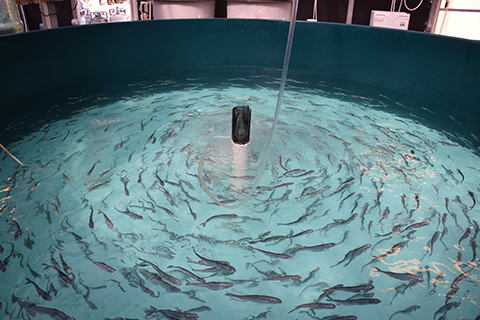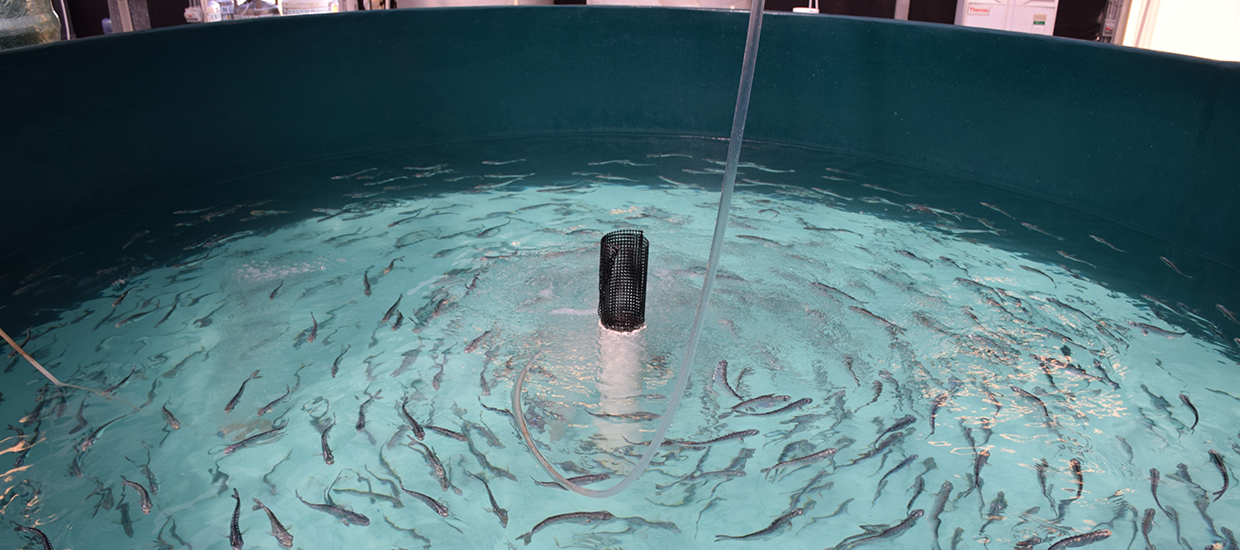- Conditioning and Spawning Systems;
- Isolation and Quarantine Tanks;
- Finfish Larval Culture Lab;
- Plankton Culture Lab;
- Aplysia Resource Facility;
- Aplysia Larval Lab;
- Outdoor Macroalgae Culture System;
- Pilot-Scale Pond Growout System;
- Combination Broodstock Holding and Finfish Growout System;
- Computerized Data Acquisition and Analysis Office;
- Food Preparation Lab;
The facility is arranged and constructed so that each section may be operated as an independent unit or integrated into any type of combination or continuous experimental configuration. The infrastructure system provides a wide range of environmental controls which furnish the facility with the unique capability of simulating a variety of environmental conditions including temperate and tropical climates.
Support Facilities
The main function of the support infrastructure is to supply a reliable flow of ambient seawater and aeration to all parts of the facility. In addition, a diesel powered 150kw generator provides emergency power to all essential pumps, chillers, incubators, blowers, and critical lighting. In addition, all essential equipment is duplicated to further insure continuous service.
Seawater is drawn from Bear Cut through dual intakes by two 900 gpm electric pumps. The water then flows into a 60,000 gallon settling tank system to remove suspended solids and particulate matter. After leaving the settling tank the water is driven through a bank of six rapid sand filters by two 500 gpm transfer pumps. The sand filters complete the process of basic mechanical filtration and the water is subsequently stored in an 8000 gallon head tank where it is available to the rest of the facility through gravity flow. (Raw water is supplied to the Broodstock Holding & Finfish Growout tanks prior to sand filtration). Two salt water wells drilled to 40' and 70' with 1 and 2 hp pumps respectively supply an alternate and completely independent source of high quality seawater for special requirements and emergency situations.
Filtered, low pressure air is supplied to the entire facility (with the exception of the phytoplankton culture lab) by two redundant, 10 hp, regenerative, high volume, low pressure blowers. The Plankton Culture lab receives air from twin piston high pressure compressors, due to the depth of the microalgae cultures.
Conditioning & Spawning Systems
The Conditioning and Spawning Systems are a dynamic, expandable series of five tanks & support components designed to provide the researcher with the ability to control critical environmental parameters over a wide range.
There are four 12 foot diameter, 3000 gallon tanks and one 5 foot diameter, 400 gallon tank. Each of the tanks can be configured as an independent system running raw seawater in a single pass flow-through, a completely closed recirculating loop, or any combination of the two. Raw seawater flow can be maintained continuously at a rate of 5 gallons per minute and is filtered with down to 10u by heavy duty cartridge filters. The recirculation system is capable of turning over 80 gpm and includes sand filtration, temperature maintenance, and a biofilter which provides both nitrification and aeration. The systems are designed to provide flexible configuration, minimal maintenance, and high reliability.
On systems one through three, system water temperature can be maintained +/-20deg.F above or below ambient, at a replacement rate as high as five gallons per minute. Systems four and five can be combined for additional heating and chilling capabilities.
Tank illumination is provided by banks of fluorescent lights independently controlled and monitored via computer. The controller is capable of providing virtually any photoperiod or light regime desired including daybreak and twilight simulations.





